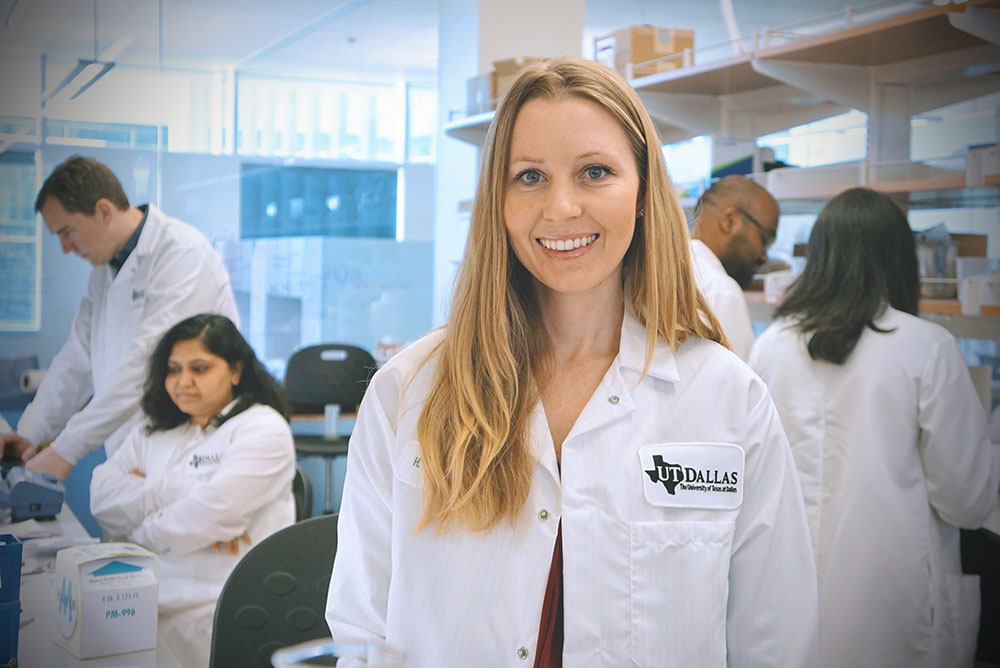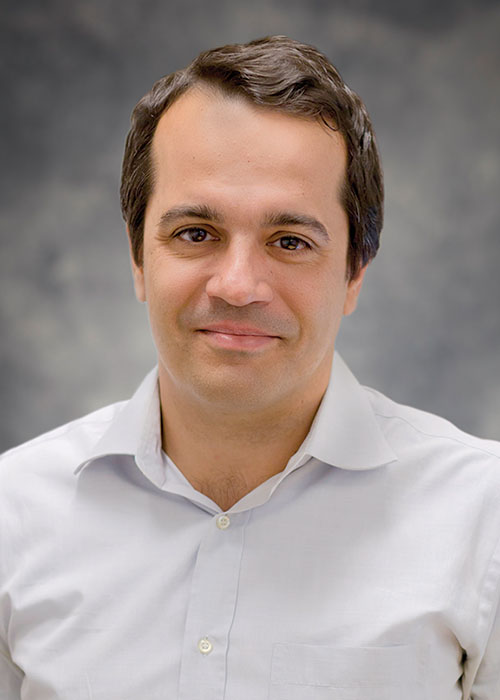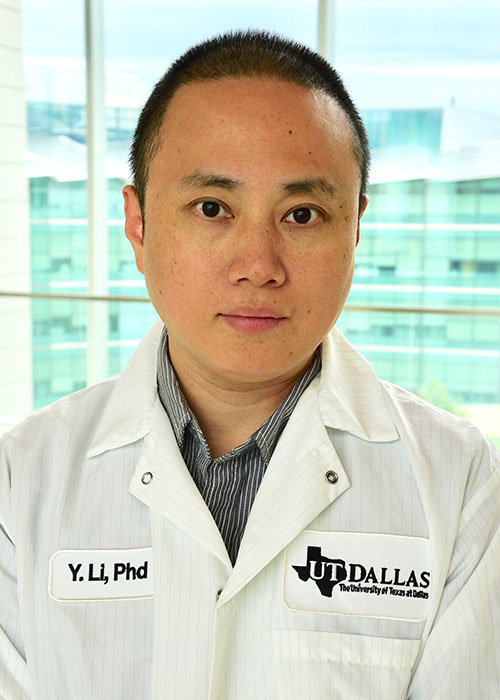UTD Bioengineer’s Rare Cancer Inspires Common Research Mission
By: Katherine Morales | Feb. 11, 2022

In 2014, only a year after Dr. Heather Hayenga first began running her own laboratory as a faculty member at The University of Texas at Dallas, she wasn’t feeling well. She had a sore throat and some hearing loss in one ear. Nothing to be too concerned about, she thought. But what should have been a routine trip to the doctor turned into something much more serious.
“I mentioned that sounds were muffled in one ear, and the doctor scheduled an MRI right away,” said Hayenga, assistant professor of bioengineering in the Erik Jonsson School of Engineering and Computer Science. “After the MRI, I was diagnosed with a brain tumor.”
Her tumor wasn’t caused by a common cancer. In fact, it is so rare that it’s diagnosed in fewer than 100 people each year. Called a solitary fibrous tumor, or SFT, it is caused by two genes fusing on one chromosome, which causes normal genes to turn into oncogenes. Oncogenes have the potential to transform a healthy cell into a cancerous cell at any time.
“This fused gene codes for a protein that switches on cancer-related genes,” Hayenga said. “I couldn’t change the cards I was dealt, but I wanted to focus on ways I could help improve knowledge of this disease and maybe further progress toward effective treatments.”
Engineering Expertise
Tapping into her own expertise in bioengineering, she researched as much as she could about her condition.
During cell division and replication, chromosome 12 gets wrapped around itself, and two genes fuse into one, causing subsequent daughter cells to replicate in the same flawed way. The altered gene codes for a protein that serves as a transcription factor, which activates cancer-related genes. The result is cells that replicate prolifically and are resistant to apoptosis, or programmed cell death, a normal process that is critical for clearing out faulty or damaged cells in the body.
“Our cells are dividing millions of times a day. Often, our immune system can detect defective cells and clear them before they turn into cancer, but not always,” Hayenga said.
The solution should be simple, she thought. Get rid of all cells with that gene fusion. But genetic engineering isn’t her field of expertise.
“From a gene engineering perspective, we have someone on faculty at UT Dallas who specializes in this — Dr. Leo Bleris,” Hayenga said. “He’s well known in genome engineering and has published studies in high-impact journals.”


After a faculty meeting one day, she told Bleris about her rare cancer and its cause. She asked if it could be further studied.
“My initial reaction was that I wanted to help and see if there was anything I could do,” said Bleris, Cecil H. and Ida Green Professor in Systems Biology Science in the bioengineering department at UT Dallas. “There was no second thought about it.”
With any rare disease, research results and funding can be limited, but Bleris’ team, spearheaded by research scientist Dr. Yi Li, used the gene-editing tool CRISPR to create an appropriate cell model that would help them understand better how the defective cells function.
Bleris explained that he and his team have tried to stay focused on the science and improving the understanding of this disease’s process.
“This is the only project over the years where I’m not thinking about funding or publishing,” he said. “This is different because it’s personal for a colleague and friend.”
‘Inspired Science’
It is not uncommon for scientists to have personal connections to what they choose to study. Hayenga’s father died of a heart attack when she was 21, which led her to focus on her current field of research — cardiovascular disease.
“Now that I have a personal connection to cancer as well, I want to try to contribute to the overall body of knowledge about my disease, in addition to searching for treatments,” she said.
In the course of her research, she has learned that the tumor is a vascular tumor and is thought to be derived from a vascular cell. With Bleris’ help, they began to create models in the lab.
“We didn’t have any of these cancer cells to study, so the first step was to go into the lab and create the cancer cells using a technique to replicate the genetic fusion. It took about eight to 12 months,” Hayenga said. “Now we can think about how to treat that cancer cell line.”
“She’s one of the bravest people I know, and I’m proud to call her a colleague. She’s using her training to solve this problem. It is inspired science.”
Dr. Joseph Pancrazio, vice president for research and innovation at UT Dallas
Hayenga’s specialty — vascular mechanobiology — made her well prepared for the pivot from studying cardiovascular disease to vascular tumors.
She also reached out to experts at UT Southwestern Medical Center who study small-molecule drug candidates and other compounds that can be screened to see if any inhibit the cancer’s growth. She also contacted the n-Lorem Foundation, which focuses on assisting patients with ultra-rare diseases.
“The foundation may create a short RNA molecule that will interfere with the creation of the protein that turns on oncogenes,” Hayenga said. “I’ve also written two case studies on my cancer since it is so rare, describing my situation in hopes that the scientific community and doctors can better treat their patients.”
She said positron emission tomography (PET) scans, for instance, don’t work as a diagnostic tool for her type of cancer because the disease doesn’t create biochemical trails revealed by the radioactive tracers used during PET scans.

To learn more about how UT Dallas is enhancing lives through transformative research, explore New Dimensions: The Campaign for UT Dallas.
Dr. Joseph Pancrazio, vice president for research and innovation at UT Dallas, said Hayenga’s ability to face her diagnosis and bring her expertise to her own disease is creating a path for others who may face a similar struggle.
“She’s one of the bravest people I know, and I’m proud to call her a colleague,” Pancrazio said. “She’s using her training to solve this problem. It is inspired science.”
In the past few years, Hayenga’s cancer has spread to other organs, including her liver, lungs and bones. She remains focused on staying healthy while she continues her efforts to create better outcomes for others and spends time with her family, including her 3-year-old son.
“One out of three people will get a cancer diagnosis in their lifetime,” she said. “But if there’s a solution out there, that search is something I can control. Hopefully we will be able to come up with something soon.”
To learn more about the UT Dallas team’s research on solitary fibrous tumors, visit its fundraising page.
Media Contact:
Katherine Morales, 972-883-4321, kmorales@utdallas.edu, or the Office of Media Relations, UT Dallas, (972) 883-2155, newscenter@utdallas.edu.





